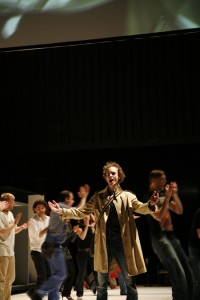Peter Handke’s texts for the theater have always been a challenge to the theater. „Die Stunde da wir nichts voneinander wussten“ is no exception: „Die Stunde“s text, which concentrates on a plaza and the movements that take place on it and which has no dialogue and reads more like stage directions, explicitly asks questions as if it didn’t know what to proscribe; it suggests movements but then negates them, stating that they should, in fact, not appear on stage.
Considering such openness and the theoretical apparatus of Roland Barthes‘ death of authors, it is no surprise that Viktor Bodó has taken Handke’s source material and gone in a totally different direction. While Handke offers us old fishermen, Moses, football teams, firemen (who may or may not be running across the stage to a fire or a drill) and women with baskets full of mushrooms, Bodó „updates“ Handke’s text with club kids, violent drunks, frustrated bureaucrats and museum guards. Bodó, in other words, challenges Handke’s challenge to theater, eschewing all of Handke’s suggestions and questions with ideas of his own. Sounds admirable, right? The problem, however, is that if you’re going to challenge/update a text or take it in another direction, you’re obligated to make it as good if not better than the original; otherwise, finding another title for your work seems advisable. Bodó, unfortunately, did not live up to his own challenge.
Bodó`s „Handke 2.0“ exploits video cameras and video screens to give the viewer a sense that s/he’s watching a movie in the making, and indeed, Bodó’s theater is very inspired by film language, music and gestures. There are slow motion scenes à la The Matrix or Crouching Tiger, Hidden Dragon, silent movie slapstick, and melodrama, all to a „jazzy“ soundtrack. But all of these felt like quotes of quotes of quotes, and like photocopies of photocopies of photocopies, at some point one’s left with an illegible mess, at some point one wonders whether it might be better to go back to the original, to figure out where everything went wrong.
The strength of Handke’s text is Bodó’s weakness. Handke creates surrealistic pictures out of simple gestures and then gives them enough space to breathe – each picture is accented with a pause, with lights on the empty plaza, with space for contemplation. In contrast, Bodó moves from one clichéd picture to the next, from one room to the next, from one physical language to the next, and from one type of film music to the next, in a velocity that would entertain any ADD-riddled MTV viewer but which leaves next to nothing to think about – and, to boot, no space to think about it. None of the pictures or scenes is very entertaining or surreal or funny, though every picture attempts to be all of these, most at the same time.
Handke makes me question what theater can be by means of space and poetry, and Bodó makes me question why I bothered to sit in the theater for one hour and a half.
